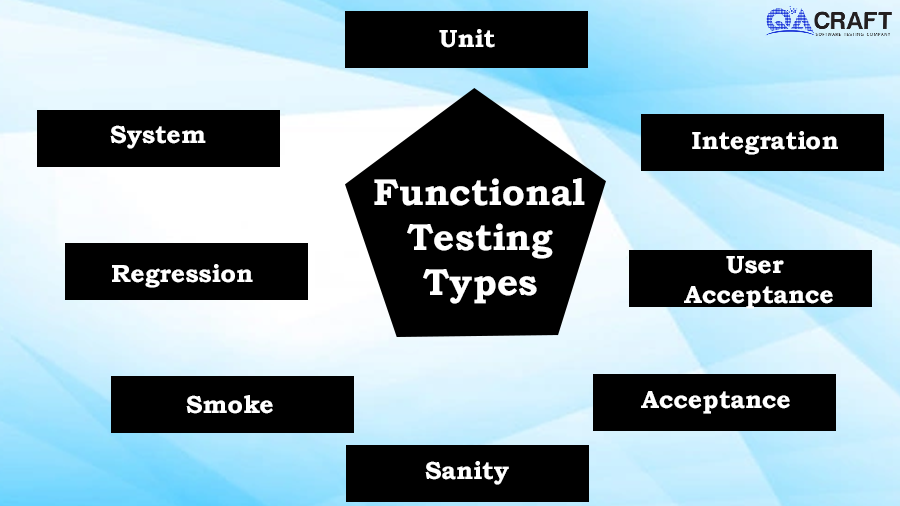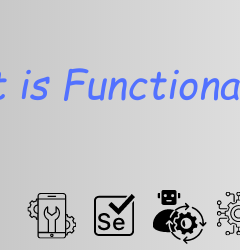17 Nov

Types of Functional Testing
Software testing has two categories: Functional Testing and Non-functional Testing.
Here are several functional testing types, such as:
- Unit Testing
Unit testing guarantees that each piece of the code created in a segment delivers the ideal yield. In unit testing, developers just look at the interface and the determination for a part. It gives documentation of code advancement as every unit of the code is completely tested independently prior to advancing to another unit.
- Integration Testing
At least two unit-tested parts of the software are coordinated together and tested to approve that the communication between them is true to form.
Three approaches for Integration Testing:
- Top-Down Approach: Modules from the high degree of either control stream or as indicated by the design configuration are tested first and the low level of modules are incorporated gradually. On the off chance that a low-level module isn’t accessible, a stub is utilized.
- Base Up Approach: In a reverse of the Top-Down methodology, low-level modules are tried first, and afterward significant-level modules are added steadily. On the off chance that an elevated level module isn’t accessible, a driver is utilized.
- Hybrid Approach: Combination of Top-Down and Bottom-Up Approaches. Testing begins at both levels and merges at the middle level.
- System Testing
All parts of the framework are joined and the framework is tried for consistency and rightness against the necessary details (Functional or System).
It is a Black-Box testing strategy, which approves the coordinated system. It’s always Tested before the User Acceptance Testing (UAT) in STLC (Software Testing Life Cycle). System Testing is acted in a practically genuine climate and as indicated by genuine utilization.
- Regression Testing
After certain upgrades or code fixes by developers, it turns out to be essential to run the relapse test suite. Relapse is rushed to guarantee that these code changes have not hampered the current working functionalities or that any new imperfection is not infused into the code. Regression experiments are the subset of existing Functional Tests, which cover the significant functionalities of the system. Regression cases should be refreshed, added, and erased by the application changes.
The Regression test cases are the best possibility for automation testing since they are run frequently and require time for execution.
Regression test cases to be run can be chosen in three different ways underneath:
- Run the entire relapse test suite
- Select the high-need experiments from the relapse suite
- Select cases from the relapse suite testing the functionalities identified with the code changes.
- Smoke Testing
After the turn of events, when another form is released, Smoke Testing is performed on the application to guarantee that all start-to-finish significant functionalities work. Smoke testing is normally accomplished for the manufacturers made during the underlying period of improvement for an application, which is not yet steady. During testing, on the off chance that any significant usefulness isn’t functioning truly to form, at that point that specific form is dismissed. Designers need to fix the bugs and make another form for additional testing.
- Sanity Testing
Sanity stability Tests are chosen from the Regression Test suite, covering significant functionalities of the application. Sanity Testing is done on the new form made by engineers for a moderately steady application. When an application effectively passes the Sanity Testing, it is prepared for the following degree of testing. It is anything but difficult to be confounded between the smoke and rational soundness testing. To test an underlying application after another form, Smoke Testing is performed. After numerous deliveries, whenever it has picked up soundness, Sanity Testing is performed on a similar application.
- Acceptance Testing
During Acceptance Testing, the acknowledgment of the application by the end client is tried. The point of this testing is to ensure that the created framework satisfies all the necessities that were settled after the business prerequisite creation. It is performed soon after the System Testing and before the last arrival of the application in reality. Acknowledgment testing turns into a basis for the client to either acknowledge or dismiss the framework. It is a Black-Box testing strategy since we are just keen on knowing the application’s preparation for the market and genuine clients.
- User Acceptance Testing
- Alpha Testing– Performed at the developer’s site by talented testers.
- Beta Testing– Performed at the client site by genuine users.
Conclusion:
QACraft believes that functional testing is critical in converting a client’s understanding of customer demands into solutions that meet those goals. Putting out software with significant functional flaws can have disastrous results. Functional testing ensures the delivery of a quality product when all of the aforementioned functional testing types are conducted at the appropriate time during the development process.
Nikhil works as a QA EngineerQACraft. Holding Diploma in Electronics engineering. He has 1+ years of experience in manual testing. Currently, he is upgrading his skills in automation testing. In his free time, he loves to travel and expanding technical skills.
Related Post
Categories
- Agile Testing
- Alpha Testing
- Android App Testing
- API Testing
- Automation Testing
- Banking Domain Testing
- Beta Testing
- cloud testing
- Corporate Life
- cross browser testing
- Cypress Testing
- desktop testing
- Difference
- Domain Testing
- E-commerce Website Testing
- E-learning App Testing
- End-To-End Testing
- Functional Testing
- Game Testing
- Healthcare Domain Testing
- Integration Testing
- Interview Questions
- ios App Testing
- Jenkins
- JIRA
- Katalon
- Manual Testing
- Mobile App Testing
- Monkey Testing
- Non-Functional testing
- Performance Testing
- Postman
- Regression Testing
- Salesforce Testing
- Sanity Testing
- security testing
- Selenium Testing
- Smoke Testing
- Software Testing
- Static Testing
- Test Case
- Test Environments
- Test Scenario
- Test Script
- TestRigor
- Web Application Testing
© Copyright 2025 QACraft Pvt. Ltd. All rights reserved.
Contact : +91 9157786796



Nikhil Trivedi